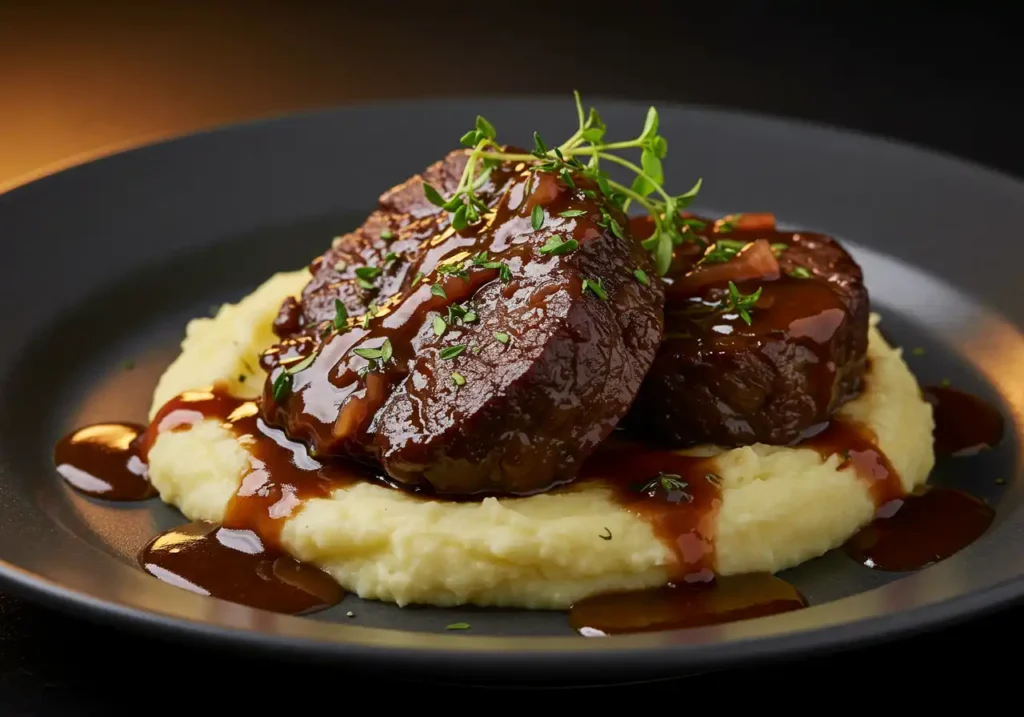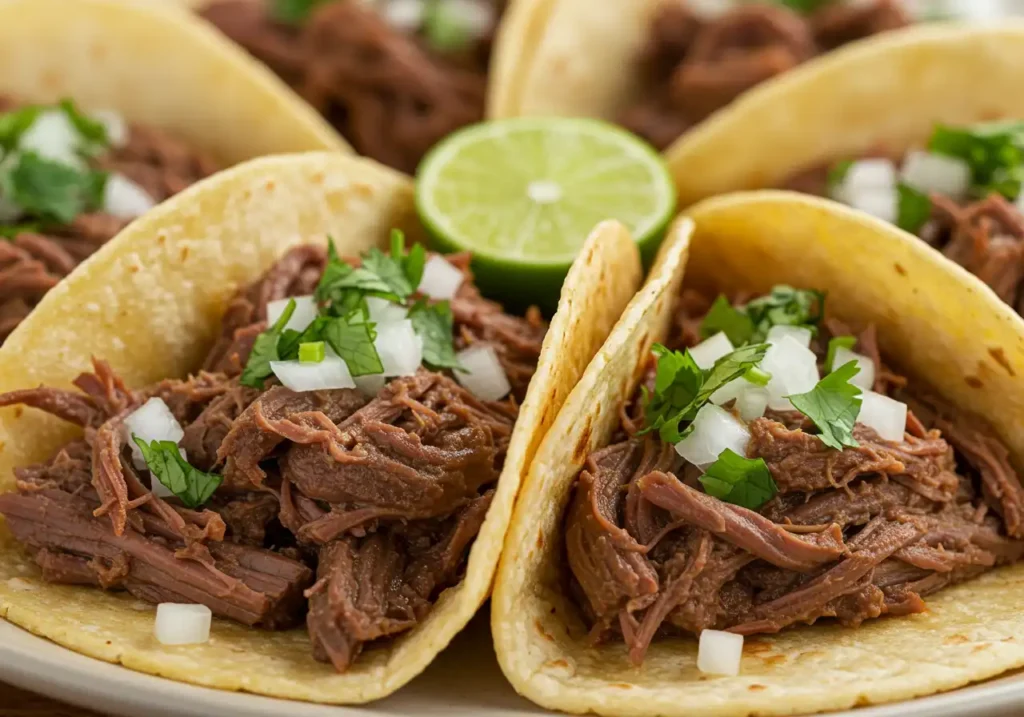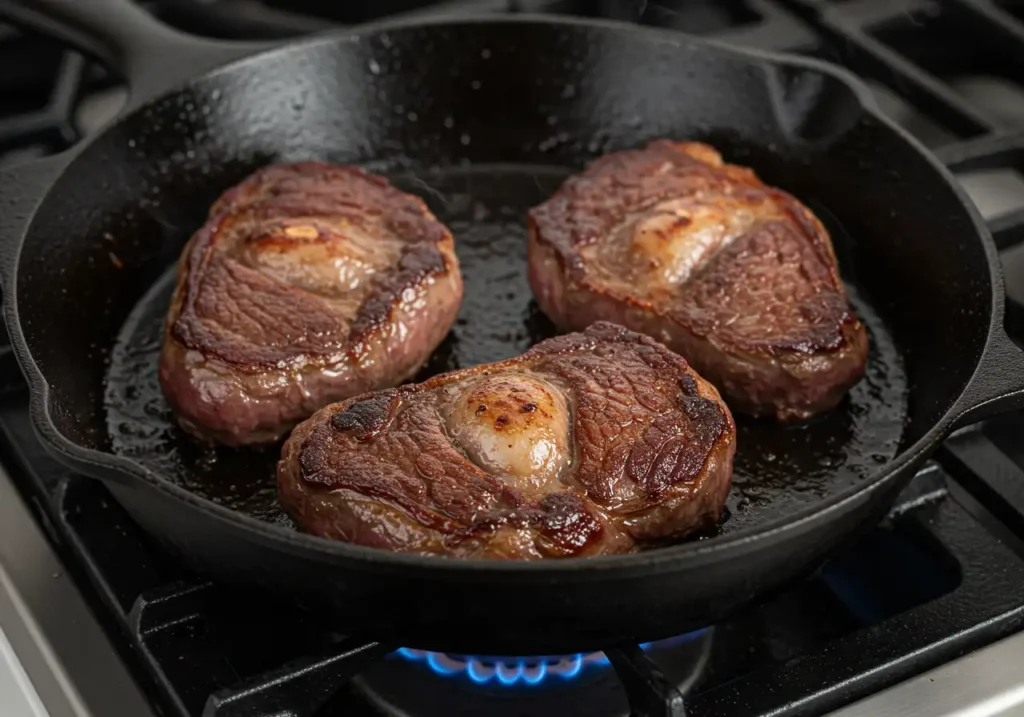Introduction – Are beef cheeks a cheap cut?
Many home cooks wonder: Are beef cheeks a cheap cut? The short answer: yes, they can be budget-friendly. However, they also pack big flavor. At the present time, more people realize that beef cheeks are full of bold taste, tenderness, and versatility. Because of this, professional chefs prize them for signature dishes. Even though beef cheeks come from a tough area on the cow, proper cooking transforms them into a melt-in-your-mouth delicacy. In the following sections, you will learn how to choose, prepare, and serve beef cheeks. You will also discover if they are actually cost-effective. Let us explore every essential detail and see how beef cheeks could become your new favorite protein.
Beef Cheeks 101
What Are Beef Cheeks?
Beef cheeks are the facial muscles of the cow. They experience constant movement because cows chew grass all day. Consequently, these muscles develop dense fibers that need slow cooking. In contrast, certain premium cuts require less time on the stove. When properly handled, beef cheeks deliver rich flavor and tender texture. They have a distinct taste that is unlike many other cuts. For instance, brisket has a smoky potential and a firmer bite. In comparison, beef cheeks boast a more delicate mouthfeel when braised.
Availability and Price
Many butcher shops do not always have beef cheeks on display. However, they can source them if you place a request. In the United States, your local butcher or grocery store might have a specialty section for off-cuts like oxtail or beef cheeks. Because these cuts are often overlooked, you can usually find them at a lower price than prime steak. Are beef cheeks a cheap cut? Yes, most of the time. Yet, as demand increases, the price sometimes rises. Therefore, keep an eye out for sales or seasonal deals to maximize savings.
Why Choose Beef Cheeks?
There are several reasons to pick beef cheeks. First, they are full of collagen, which is a protein that contributes to a hearty, silky sauce. Second, they become exceptionally tender with the right cooking method. Third, they have a captivating flavor profile that pairs well with many dishes. For instance, you can braise them with vegetables or shred them for tacos. Furthermore, they offer a break from the usual beef cuts such as ribeye or ground beef. In addition, beef cheeks are easy to find if you know where to look.
Cooking Methods: Transform Tough to Tender
Braising Basics
Braising is the most popular method to cook beef cheeks. This method involves searing the cheeks in a hot pan until browned. Next, you simmer them in a flavorful liquid at a low temperature. Over time, the dense muscle fibers break down. To illustrate, place seared cheeks in a Dutch oven with onions, carrots, and celery. Then cover them with beef stock and let them cook gently for about three hours. Eventually, the tough meat will become fall-apart tender.
Slow Cooker Convenience
If you prefer a hands-off approach, use a slow cooker. First, sear the cheeks in a skillet to lock in flavor. Then transfer them to your slow cooker with aromatic seasonings. In contrast to quick searing, slow cooking demands patience. However, the result is worth it. Add a bit of tomato paste, garlic, and onions. Let the slow cooker run on low for eight hours. Because of the prolonged simmer, everything melds into a hearty stew. You can serve it over mashed potatoes, polenta, or even a bed of steamed rice.
Pressure Cooking for Speed
For those in a hurry, a pressure cooker is the ideal tool. This method shortens cooking time significantly. Sear the beef cheeks until browned. Then place them in the cooker with your chosen liquid. Set the timer for about 45 to 60 minutes, depending on the thickness of the cheeks. The pressure helps break down the muscle fibers at a faster rate. In the meantime, you can prepare a simple side dish. For example, you could stir-fry vegetables or make a quick salad. Once the cheeks are done, they should be fork-tender and ready to enjoy.
Flavor Pairings and Seasonings
Herbs and Spices
Beef cheeks shine when paired with the right flavors. Common additions include garlic, onions, thyme, rosemary, and black pepper. In contrast, you can opt for international seasonings like chili powder or cumin to create a Southwestern twist. Because of their meaty richness, beef cheeks can handle bold spices. For instance, you can add paprika or dried oregano. Therefore, do not be shy about experimenting. However, try to balance strong spices with fresh herbs or mild vegetables.
Sauces and Liquids
A rich sauce complements beef cheeks perfectly. You can simmer them in beef stock or tomato-based liquids. In addition, you can blend in some diced tomatoes, vegetable broth, or a bit of citrus to lighten the dish. For instance, a squeeze of lemon brightens the flavors and cuts through richness. Some people also enjoy a hint of soy sauce for an umami boost. However, avoid sauces containing pork or bacon to keep this dish aligned with certain dietary preferences.
Serving Suggestions
Once your beef cheeks are done, you have many serving options:
- Shred them for tacos or enchiladas.
- Serve them whole with mashed potatoes.
- Pair them with roasted vegetables like carrots or parsnips.
- Lay them atop creamy polenta or risotto.
- Slice them thinly and drizzle with pan sauce.
In addition, consider garnishing with fresh herbs for a vibrant finish. Because beef cheeks are a warming dish, they are perfect on chilly evenings. For instance, you can serve them at a family gathering or a cozy dinner party. In contrast, if you want a lighter approach, pair them with a crisp green salad.
Nutritional Data for Beef Cheeks
It is important to stay informed about the nutritional value of your meals. Below is a table summarizing the approximate nutrition for one 3-ounce serving of beef cheeks. This data may vary based on cooking method and ingredients added.
| Nutrient | Approximate Amount (per 3 oz) |
|---|---|
| Calories | 160 |
| Protein | 23 g |
| Total Fat | 7 g |
| Saturated Fat | 3 g |
| Cholesterol | 70 mg |
| Carbohydrates | 0 g |
| Iron | 15% DV |
| Sodium | 70 mg |
This simple table covers the basics. In conclusion, beef cheeks offer a decent protein source with moderate fat content. Are beef cheeks a cheap cut? Undeniably, they can be cost-effective. However, they are also nutritious. Therefore, you can enjoy them without breaking the bank.
From Tough to Tender: The Science Behind Beef Cheeks
Collagen and Connective Tissue
Collagen is key to the tenderness of beef cheeks. At the present time, scientific understanding of cooking shows that long, slow methods best dissolve collagen. That process creates a gelatin-like texture. For instance, you might notice a rich, almost sticky mouthfeel in a braised beef cheek dish. In contrast, if you cook them too quickly at high heat, the meat becomes chewy. Because of this, patience is essential.
Cooking Times and Temperatures
Different cooking appliances might vary in temperature settings. However, the principle remains the same. Low and slow cooking at about 300°F to 325°F in the oven or on a stovetop simmer is ideal. For instance, plan on at least three hours for braising or eight hours in a slow cooker. In comparison, pressure cooking shortens that time to under an hour. However, the flavor can be equally impressive if you use aromatic ingredients.
Creating a Luxurious Sauce
Beef cheeks release succulent juices while cooking. Therefore, the residual liquid often becomes a glossy sauce. To demonstrate, you can reduce the braising liquid by simmering it uncovered until thickened. Stir occasionally to prevent burning. You may add cornstarch or flour if you prefer a thicker gravy. In the meantime, taste the sauce and adjust seasoning with salt or herbs.
Are Beef Cheeks a Cheap Cut? Factors That Affect Price
Regional Variations
Are beef cheeks a cheap cut? That depends on where you live. In some urban areas, specialty butcher shops might charge more because of limited supply. In rural locations, you might find them at a lower cost. Therefore, it pays to ask local butchers or farmers about availability.
Market Demand
When demand for a certain cut rises, prices follow. In recent years, more food bloggers and chefs have showcased beef cheeks. Because of that, some consumers now seek them out. In contrast, they used to be considered a scrap or off-cut. Keep an eye on local stores to spot deals. You might find that the price can fluctuate throughout the year.
Buying in Bulk
Bulk purchases often come with discounts. For instance, if you decide to buy a larger portion of beef cheeks, you might save money per pound. In addition, you can freeze extra cheeks for future meals. However, always label your packages with the date to keep track of freshness.
A Quick Joke to Spice Things Up
Let us take a brief detour and lighten the mood. Ever wonder why the cow gave a stand-up comedy performance at the county fair? Because her cheeks were “well-seasoned” for roast beef! Ba-dum-tss! Alright, that joke may be a tad cheeky. However, hopefully it made you grin. Food can be serious, but a little humor never hurts.
Popular Recipes Featuring Beef Cheeks
Classic Braised Beef Cheeks
- Ingredients: Beef cheeks, onions, carrots, celery, garlic, beef stock, tomato paste, salt, pepper, herbs.
- Method: Season and sear the cheeks. Sauté veggies in the same pot. Stir in tomato paste and stock. Add cheeks back in. Cover and braise for about three hours at 325°F. Serve with mashed potatoes or polenta.

Beef Cheek Tacos
- Ingredients: Beef cheeks, onion, garlic, chili powder, cumin, salt, pepper, tortillas, cilantro, lime.
- Method: Season the cheeks with chili powder and cumin. Sear them. Place them in a slow cooker with onion and garlic. Cook on low for eight hours. Shred the meat and serve in warm tortillas. Top with fresh cilantro and a squeeze of lime. In addition, you can add salsa or guacamole.

Shredded Beef Cheek Sandwiches
- Ingredients: Beef cheeks, onion, BBQ sauce (or a homemade sauce without bacon), pickles, buns, lettuce.
- Method: Prepare and cook the cheeks in a pressure cooker with onion and seasonings. After cooking, shred the meat, mix in some BBQ sauce, and serve on soft buns. Add pickles and lettuce for texture. Because these sandwiches are hearty, they make a quick lunch or simple dinner.
Step-by-Step Guide to Cooking Beef Cheeks at Home
Below is a bullet-point guide to help you cook beef cheeks with confidence:
- Choose Fresh Cheeks
- Look for firm, fresh beef cheeks with a deep-red color.
- Ask your butcher if the cheeks are trimmed of excess fat.
- Pre-Season and Marinate
- Pat the cheeks dry.
- Season liberally with salt, pepper, or your preferred spice blend.
- Optional: Marinate overnight for deeper flavor.
- Sear for Flavor
- Heat a tablespoon of oil in a heavy pan.
- Brown each side of the beef cheeks to lock in juices.
- Remove them and set aside.

- Sauté Aromatics
- In the same pan, cook onions, carrots, celery, or garlic until softened.
- Stir in tomato paste for added richness.
- Deglaze the Pan
- Pour in a splash of beef stock or water.
- Scrape up browned bits at the bottom (they contain flavor).
- Combine and Simmer
- Return the cheeks to the pan with enough liquid to cover at least halfway.
- Add herbs (thyme, rosemary, etc.).
- Cover the pot and simmer gently for about three hours.
- Alternatively, use a slow cooker or pressure cooker.
- Check for Doneness
- Test by pressing a fork into the meat.
- If it yields easily, you are good to go.
- Reduce the Sauce
- Remove the cheeks.
- Boil the remaining liquid to thicken it.
- Season with salt and pepper to taste.
- Serve and Enjoy
- Return the cheeks to the sauce or slice them for plating.
- Garnish with fresh herbs if desired.
Frequently Asked Questions (FAQs)
Below are some common queries people have about beef cheeks, cooking methods, and cost considerations.
- How do I store beef cheeks before cooking?
Keep them in the refrigerator for up to two days if you plan to cook soon. Otherwise, freeze them in airtight containers or freezer bags. - Can I cook beef cheeks without searing?
Technically, yes. However, searing develops a deeper flavor and color in the final dish. Therefore, it is recommended. - How do I know if my beef cheeks are done?
They should be fork-tender. When you can gently pull them apart with a fork, they are ready. - What side dishes work best with beef cheeks?
Mashed potatoes, roasted vegetables, polenta, or fresh salads all pair nicely. In addition, bread rolls can soak up the sauce. - Do beef cheeks have a strong beefy flavor?
Yes, they are quite rich. However, proper seasoning and cooking balance the flavor nicely. - Are beef cheeks healthy?
They are a good source of protein and essential nutrients like iron. Because they do contain fat, moderation is key. - Where can I find beef cheeks if they are not in my local store?
Ask your butcher for a special order. You can also search online suppliers that deliver to your area. - Can I use beef cheeks in a soup?
Absolutely. Just remember to cook them long enough to break down the connective tissue. The result is a rich, meaty broth. - Are beef cheeks similar to oxtail?
They share some similarities in richness and collagen, but the flavor and texture differ. Oxtail contains more bones and connective tissue. - Are beef cheeks a cheap cut? How does the price compare to other cuts?
In many places, beef cheeks are cheaper than steak or ribs. However, availability and demand can influence the final price. - Are beef cheeks good meat? Yes. Beef🥩 cheeks are a delicious, collagen-rich cut. When cooked properly, they become incredibly tender and flavorful…
- Why is beef cheek so expensive? In some areas, beef🥩 cheeks cost more because they aren’t as widely available. Also, each cow yields a limited amount of cheek meat, which drives up demand…
- Is beef cheek slimy? Well-cooked beef🥩 cheeks shouldn’t feel slimy. They do get moist and gelatinous due to collagen breakdown. But if prepared correctly, they’re velvety and fork-tender, not slimy…
Conclusion – Are beef cheeks a cheap cut?
In conclusion, Are beef cheeks a cheap cut? Yes, in most markets they are indeed a budget-friendly option. However, they also deliver luxurious flavor when cooked properly. Because they contain a high level of collagen, you can create silky, melt-in-your-mouth meals. This hearty cut is perfect for slow cooking, braising, or pressure cooking. Whether you serve them in tacos, stews, or sandwiches, beef cheeks can become your new go-to comfort food. Next time you want an economical yet gourmet-style meal, remember beef cheeks. They prove that sometimes the tastiest parts of the cow come from unexpected places.
–



